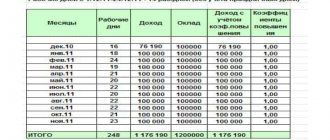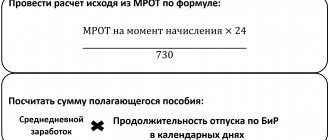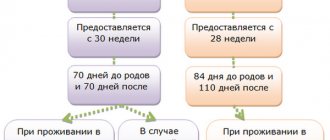Who is entitled to additional leave for harmful activities?
Additional vacation days should be provided to those whose workplace is classified as dangerous or harmful working conditions of the 2nd, 3rd or 4th degree. The employer receives such information from experts based on the results of a special assessment of working conditions (SOUT), which is required to be carried out once every 5 years.
It happens that the working conditions of workers were recognized as harmful or dangerous even before 2014, when the rules for certification of workplaces were in effect. Even if SOUT has not yet been carried out, all old benefits for pest workers remain, including the right to additional leave.
Some industries, professions and positions give the right to additional leave without special assessment or certification. For example, if they are listed in the List approved by the Decree of the State Committee of Labor of the USSR, the Presidium of the All-Union Central Council of Trade Unions No. 298/P-22 dated October 25, 1974. The duration of the vacation is also stated in it. Thus, an electric manual welder is entitled to 12 additional days of vacation when working indoors. A painter working with a brush with nitro paints – 6 days. If the employer has not carried out certification or a special assessment, benefits for harmful workers should be provided based on the list.
Additional leave for harmful activities is usually added to the main annual leave.
Results
Only those specialists whose jobs belong to the 2nd–4th degree of hazardous conditions can count on leave for hazardous working conditions in 2022. At the same time, if an employee until 2014 performed work, even classified as 1st degree of harmfulness, and his working conditions did not change, then he has the right to continue to receive leave for harmfulness until he quits or until the company will not change his working conditions. To determine the duration of such leave, an enterprise should be based on the time (in full months) during which the employee actually worked in hazardous work. In this case, the vacation in question should not be less than 7 days. It is important for the employee not to forget that if the company provides him with additional leave longer than 7 days, then instead of such leave he can ask for a cash payment (but only for that part of the leave that exceeds the minimum of 7 days).
Our online calculator will help you calculate vacation pay correctly.
Sources:
- Labor Code of the Russian Federation
- Resolution of the State Labor Committee of the USSR, All-Union Central Council of Trade Unions dated November 21, 1975 No. 273/P-20
You can find more complete information on the topic in ConsultantPlus. Free trial access to the system for 2 days.
Duration and terms of additional leave
The minimum duration of annual additional leave, which is established for a pest worker during a special assessment, is 7 calendar days per year.
The number of days may be greater if this is stipulated in the collective agreement or the employer is subject to an industry or inter-industry agreement. The exact duration of leave is indicated in employment contracts.
For example, for construction organizations, the industry agreement of the Ministry of Construction No. 17/20-23 dated December 1, 2022 is in force. It states that the annual additional leave for pests increases by at least 3 calendar days for each degree of harm above 2nd (class 3.2) , and for work with hazardous working conditions (class 4) its duration is at least 14 calendar days.
Employees go on additional vacation according to the vacation schedule drawn up by the employer. In this case, the number of days is calculated in proportion to the time actually worked in harmful conditions. Unlike the main annual leave, additional annual leave cannot be obtained in advance.
When are working conditions considered harmful?
Currently, the presence of harmfulness can only be determined based on the results of the assessment assessment. Indicating a profession or position in Lists No. 1 and No. 2[1] is not yet a reason to provide guarantees and compensation for work in harmful conditions.
The Constitutional Court of the Russian Federation, in its Ruling dated 02/07/2013 No. 135-0, confirmed that the harmful effects of factors must necessarily be confirmed by certification of workplaces (and now SOUT, which replaced certification). And vice versa, if the position is not on the Lists, and the assessment system has revealed excess exposure to harmful factors, then the conditions will still be considered harmful (Decision of the Moscow City Court dated December 12, 2014 in case No. 7-9197).
Working conditions during SAW will be considered harmful if the level of exposure to harmful and dangerous production factors measured by specialists exceeds the standards. Since the impact varies, harmful conditions are divided into 4 subclasses: 3.1, 3.2, 3.3, 3.4, according to the degree of increase in health hazard.
There is another 4th class - hazardous working conditions. In such conditions, the likelihood of occupational diseases or injury is very high.
How to calculate the number of vacation days for pest workers
The length of service that entitles you to leave for hazardous work includes only time worked in hazardous conditions. Experience is counted from the date of commencement of work. In this case, every 30 calendar days are converted into full months, and every 12 months - into years.
Periods when the employee was not in harmful working conditions are excluded from the length of service:
- annual leave;
- temporary disability.
The rules for calculating length of service for hazard leave are given in clauses 8-12 of the Instructions, approved. By Decree of the State Committee for Labor of the USSR, the Presidium of the All-Union Central Council of Trade Unions No. 273/P-20 dated November 21, 1975. It is applied to the extent that does not contradict the Labor Code of the Russian Federation. For example, the instructions say that the length of service must include a period of temporary disability. From 01.02.2002 this clause was declared ineffective.
As of 04/01/2017, the paragraph stating that days worked in hazardous conditions for less than half a working day are not counted towards vacation experience. Now part-time days are taken into account even if the employment rate is less than 0.5.
Additional leave is provided for each working year, that is, 12 full months from the date of hire. If an employee works in harmful conditions for at least 11 months in a working year, he will receive full leave. If less - in proportion to the time worked.
This is how days of additional leave are calculated if an employee worked in hazardous work for less than 11 months.
- Determine the average monthly number of working days. Divide the number of working days in a year by 12 months.
- Calculate how many full months the employee worked in hazardous conditions. Divide the “harmful” days worked during the working year by the average monthly number of working days. Round the result to a whole number according to the rules of mathematics. If the number after the decimal point is less than 5, simply discard the extra digits; from 5, round up.
- Calculate the number of vacation days for harmful activities. Divide the days of full leave for hazardous conditions by 12 months and multiply by the full months worked in hazardous conditions.
If the number of vacation days is not a whole number, it is rounded in favor of the employee (recommendation from letter of the Ministry of Labor No. 14-2/B-1045 dated October 18, 2016). For example, a value of 4.3 is rounded up to 5 days. The work year may span different calendar years. Then the calculation is done for each year separately and the results are summed up.
An example of calculating additional leave for harmful activities
The driver was hired on January 11, 2022. Based on the results of the special assessment, he was given additional annual leave of 7 calendar days. According to the schedule, the driver goes on vacation from August 30, 2021.
The driver worked in hazardous conditions for 129 days, and the total working days from the date of his appointment to the start of his vacation was 160.
The number of working days in 2022 according to the production calendar is 247.
Let's calculate how many vacation days a driver is entitled to for damages.
- Average monthly number of working days: 247 / 12 = 21.
- Number of full months due to harmful conditions: 129 / 21 = 6.1. Round up to 6.
- Number of vacation days for harmful activities: 7 / 12 * 6 = 3.5. Round up to 4.
Calculation of the duration of leave for harmful working conditions
As follows from Art. 117 of the Labor Code of the Russian Federation, additional leave for harmful working conditions should be more than 7 days.
NOTE! Moreover, if the company has established such leave in a larger amount, then the employee has the right to ask for monetary compensation instead of leave, but only for that part that exceeds 7 days (Article 117 of the Labor Code of the Russian Federation). For example, an employee is entitled to 10 calendar days of work leave, of which he must take 7 days off, and for 3 he can receive monetary compensation. Replacement of vacation with monetary compensation is carried out on the basis of the written consent of the employee
However, how to calculate exactly how many days an employee is entitled to?
When granting regular leave, the number of days due to the employee is determined based on the number of days he worked in the organization. Similarly in the case of leave for hazardous work: it is due only for those days that the employee actually worked in conditions that pose a potential danger to his health (Article 121 of the Labor Code of the Russian Federation). Moreover, if an employee was not present at work on any days without a good reason, was suspended from work due to his own fault, and also if he was on maternity leave, then such days cannot be counted toward the vacation period for harmful production. (Article 121 of the Labor Code of the Russian Federation).
IMPORTANT! If the employee was not actually present at hazardous work due to the state. holidays, was suspended from work through no fault of his own or was fired illegally, then his length of service for the purpose of determining the duration of leave for hazardous work is not interrupted (Article 121 of the Labor Code of the Russian Federation).
Otherwise, the number of days of additional leave for an employee who works at 0.5 rate is calculated. He is also entitled to leave of a minimum duration of 7 calendar days, but the length of service for calculating the remaining days does not include days when the employee did not work or worked less than half the working day established for this category of employees.
Having found out how many days the specialist was employed under hazardous conditions, then you need to group these days and determine the number of months fully worked under the specified conditions. This can be done using the following formula (clause 10 of the Instructions):
K neg. m = Day neg / (K day in year / 12),
Where:
Kotr.m - the number of full months that the specialist worked in hazardous conditions;
Dnotr - the number of days during which the specialist performed hazardous work;
Kdn per year - the number of working days in the accounting year.
IMPORTANT! If the result is 11 months, then the specialist must receive leave as for a fully worked year (clause 8 of the Instructions).
Next, the duration of leave for harmful activities is determined directly using the formula:
Pr from = To neg.m × Day per year / 12 – D isp,
Where:
Prot - duration of vacation;
Day per year - number of additional days. vacations per year, which the company, due to the provisions of the labor (collective) agreement, provides for harmful activities;
Disp - extra days vacations that the employee has already used.
An example of calculating payment for additional leave for harmful activities from ConsultantPlus The employee goes on leave for harmful activities from 10/12/2021 for 10 working days. For the billing period from 10/01/2020 to 09/30/2021, a salary of 600,000 rubles and vacation pay of 62,100 rubles were accrued. and sick leave 12,900 rubles. He was sick from 03/13/2021 to 03/24/2021 (10 working days) and was on vacation from 07/02/2021 to 07/29/2021 (24 working days). The number of days worked during the billing period according to the six-day working week calendar is 266 days. (78 days + (222 days - 10 days - 24 days)). The basis for calculating vacation pay... You can view the entire example in K+ by getting free trial access.
What to do if additional leave is indicated in working days
Basic paid leave is calculated in calendar days. But the duration of additional leave for pests can be set among workers. This happens when the employer has not yet conducted a special assessment and is guided by a list of hazardous industries, workshops, professions and positions. In this case, working days must be converted into calendar days.
- Determine the start of the hazard leave. If additional leave is granted simultaneously with the main leave, then the start date will be the day following the last day of the main leave.
- From the received date, count the working days of additional leave according to the calendar, but according to the schedule of a six-day working week, that is, together with Saturday.
- Calculate how many calendar days there are from the beginning of the sick leave until the last day inclusive.
For example, from August 17, 2022, the pest worker begins an additional vacation of 7 working days. We need to convert them to calendar ones. According to the six-day workweek schedule, the last day of vacation is August 24, 2022. The number of calendar days of leave for harmful activities is 8.
How to calculate actual days worked
First you need to count the days actually worked in hazardous work. They are calculated as follows (Article 121 of the Labor Code of the Russian Federation, paragraph 12 of the Instructions):
- if in the column “Name of production, workshops, professions and positions” of the List in relation to a profession (position) there is an entry “permanently employed” or “permanently working”, only the days when the employee was employed full-time in the corresponding job are included;
- if there is no such entry in the List, only the days when the employee was engaged in hazardous work are included.
The remaining days, including days of vacation or illness, are not included in the length of service for additional leave “for harmfulness”.
Is it possible to replace vacation for harmful activities with monetary compensation?
It is possible to replace unused additional leave for harmful activities with monetary compensation, but only to the extent exceeding 7 calendar days (Letter of the Ministry of Labor No. 15-1/OOG-1710 dated June 18, 2020).
The procedure, size and conditions of such replacement must be specified in the industry (inter-industry) agreement and in the collective agreement. Written consent must be obtained from the employee and formalized as a separate agreement to the employment contract.
Compensation for unused vacation of a pest worker, which does not exceed 7 days, can be paid only upon dismissal.
Penalties for failure to provide leave
An employer who does not provide a harmful worker with additional annual paid leave violates Art. 114 Labor Code of the Russian Federation. For this, the labor inspectorate punishes with fines under Part 1 of Art. 5.27 Code of Administrative Offenses of the Russian Federation:
- organizations - from 30 to 50 thousand rubles;
- officials and individual entrepreneurs - from 1 to 5 thousand rubles.
For repeated violations, fines increase (Part 2 of Article 5.27 of the Code of Administrative Offenses of the Russian Federation):
- for organizations - from 50 to 70 thousand rubles;
- for officials - from 10 to 20 thousand rubles. or disqualification for a period of 1 to 3 years;
- for individual entrepreneurs - from 10 to 20 thousand rubles.
There are relaxations only for representatives of small and medium-sized businesses. Their fines may be replaced with a warning if this is the first time they have violated labor laws.



